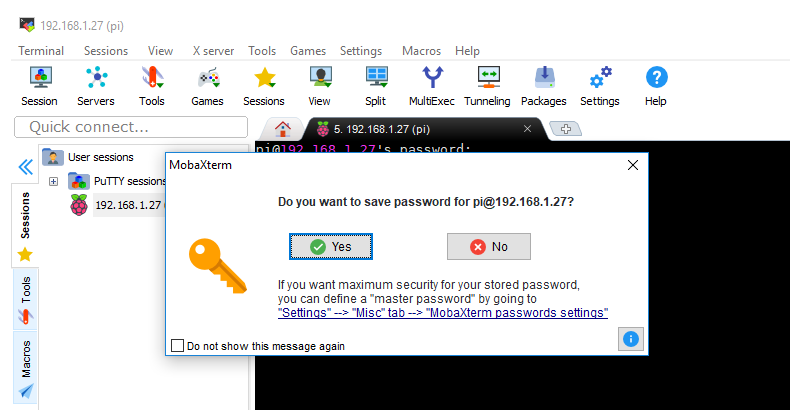

- #MOBAXTERM RASPBERRY PI STARTX HOW TO#
- #MOBAXTERM RASPBERRY PI STARTX INSTALL#
- #MOBAXTERM RASPBERRY PI STARTX FULL#
#MOBAXTERM RASPBERRY PI STARTX INSTALL#
On the Windows workstation, install and run an X-Windows server, such as XMing or MobaXterm. " Maybe someone here uses his headless Raspberry Pi with GUI and can help me how this can be done or some expert can direct me to the information I need to acomplish this."Įnable the sshd daemon on RasPiOS on the RPi, so you can log in via ssh. Please keep in mind that I'm new to the Raspberry Pi and to Linux, but I'm strong with Windows and technology in general. Maybe someone here uses his headless Raspberry Pi with GUI and can help me how this can be done or some expert can direct me to the information I need to acomplish this. I'm not sure what exactly you want, but startx will start an X server on the local machine, which doesn't make any sense over an ssh connection, as this X server would use local graphics hardware for display (so, you won't see anything on your client) and you already have your X server running on your remote machine (the ssh client). Google isn't very helpful with this, as I only find solutions or documentation for systems where a display is connected. I have no idea if this is possible and if, how or where I have to configure it. I have to make it think, that there is a display with a set resolution. I think it is the same, to get the X-server to work. To get TeamViewer to work when the Raspi booted to GUI, it was essential to define a resolution in raspi-config. while in Debian-based operating systems this is done with. In RHEL-based distributions installing Xorg is accomplished by doing. xinitrc - but if you don't want to edit config files the above command will work okay. Looks like a problem similar to the problems i had before using TeamViewer without a real display but now I have no clue where to start troubleshooting - so here I am What you need is pretty simple : a minimal Linux distribution or a similar Unix-like OS with the desired X applications installed and Xorg. The right way to launch X is to use startx or xinit as these programs will start the X server, wait until it's running and can receive connections, and then execute the contents of. I configured it accordingly, but now, when I try to start x, i get errors and the GUI won't start. The "last" thing i wanted to do ist to let the Raspi boot to CLI and not to the GUI to save resources. I had some problems with TeamViewer and a headless system, but now everything is running fine so far. I have installed Raspberry Pi OS with Desktop which I want to use with TeamViewer and of course ssh. It's a headless system I want to use mainly for home automation and some playing around. I have a Raspberry Pi 4 8GB running off a SSD. (I'm not familiar enough with the internals of X to tell whether or not you need to do something in your program to make that happen.) Anyway, you can consider using a lightweight WM that allows you to start a program in fullscreen upon its startup.Hi, I'm new to the Raspberry Pi and I have trouble to start the X-server temporarily. I'm not sure if the DE/WM-less approach will guarantee that the program will run in fullscreen. With that said, you can see if these fit for your use case: However, AFAIK it's a bit tricky to do remotely (if possible at all) because of the tty stuff and so on.

To do that you could make the program as the main/only client of the server with xinit / startx. DISPLAY=:0 xeyes).Īs for your "real" question, you'll need an Xorg server running on the Pi itself anyway if you want to have the program show itself on the DSI display. So first of all to make it use a local X server, either ssh without -X (or, use -x to disable it explicitly) or use an appropriate DISPLAY environment variable when you run the program (e.g. localhost:10.0 indicates that it's trying to make use of X11 Forwarding to make itself show on your SSH client, probably because you have enabled it on the server and is using -X or equivalent client conf. I don't think the error you saw is actually relevant to what you want to achieve. What would be the starting point for this? tupUi(self) # gets defined in the UI file In the end I would like to run a Qt app started as a service after the boot: import sysĬlass MainWindow(QMainWindow, mainwindow_auto.Ui_MainWindow): How can I run xeyes in fullscreen mode from my ssh remote?
#MOBAXTERM RASPBERRY PI STARTX HOW TO#
I suppose then I need to run my app through some wrapper, but I don't really understand how to do it. Starting again lxde I notice it runs over xorg # ps -axu | grep xorg What I tried is to stop lxde and naïvely start an app: # service stop lxdeĮrror: Can't open display: localhost:10.0 I currently interact with my device through SSH.
#MOBAXTERM RASPBERRY PI STARTX FULL#
Instead I would like to start a single app in full screen mode. I've installed lxde but I don't want to use it. I've got a RPI4 with a DSI touch display.


 0 kommentar(er)
0 kommentar(er)
